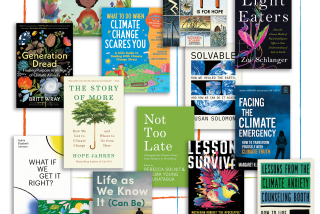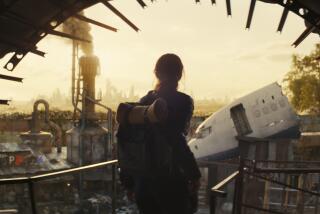NOBODY WANTS A NUCLEAR WAR, written and illustrated by Judith Vigna (Albert Whitman & Co., 5757 W. Howard St.; Niles, Ill. 60648; 40 pp.; ages 6-9).
- Share via
Childhood during the ‘50s was idyllic even when the air-raid siren on our corner blasted every week or so. After all, our parents consoled, the siren was just a drill and not to worry. In school we tucked ourselves under desks, then at the teacher’s whistle, we filed out of class to walk home and play. Another drill, another day. No one told us what would really happen if bombs dropped.
Children of the ‘80s know better. In between “Sesame Street” and “The Brady Bunch,” TV beams news about nuclear winter and radiation sickness, especially in the wakes of Three Mile Island and Chernobyl. An alarming suggestion is that the rise in adolescent suicide is linked to a despair that kids feel about our planet’s future. It’s this worry that Judith Vigna confronts in her excellent picture book, “Nobody Wants a Nuclear War.”
A brother and sister are reading a magazine with a mushroom cloud on its cover and talking about being scared that they’ll never grow up. “There’ll be no more houses or trees or animals or parents. Only a dark, smoky desert like we saw on television.” They sneak to the woods behind their house where they build a hideaway in a secret cave, “just in case.” When their mom finds them, she hugs them and listens. Then she tells about the air-raid drills of her childhood and that she, too, had wondered if she’d ever live to grow up.
She comforts them by explaining “that lots of grown-ups all over the world will never ever stop working to prevent nuclear war.” Even the teensiest effort helps, such as the letters their neighbor writes to newspapers and the community group that sometimes holds peace rallies. Now encouraged, the children plunge into a homemade project so that their small voices will be heard.
The clear, strong message here is that hope exists. The subtle message is that we parents need to continually check the feelings and fears of our youngsters. We need to reassure them, and ourselves, that “we all have the same goal--to make the world safer. . . .” Vigna’s illustrations alternate between the warmth of color and the starch of black-and-white, perhaps a cost-saving measure on the part of the publisher. Whatever purpose, the interruptions keep readers alert. That’s probably not a bad idea.
More to Read
Sign up for our Book Club newsletter
Get the latest news, events and more from the Los Angeles Times Book Club, and help us get L.A. reading and talking.
You may occasionally receive promotional content from the Los Angeles Times.







